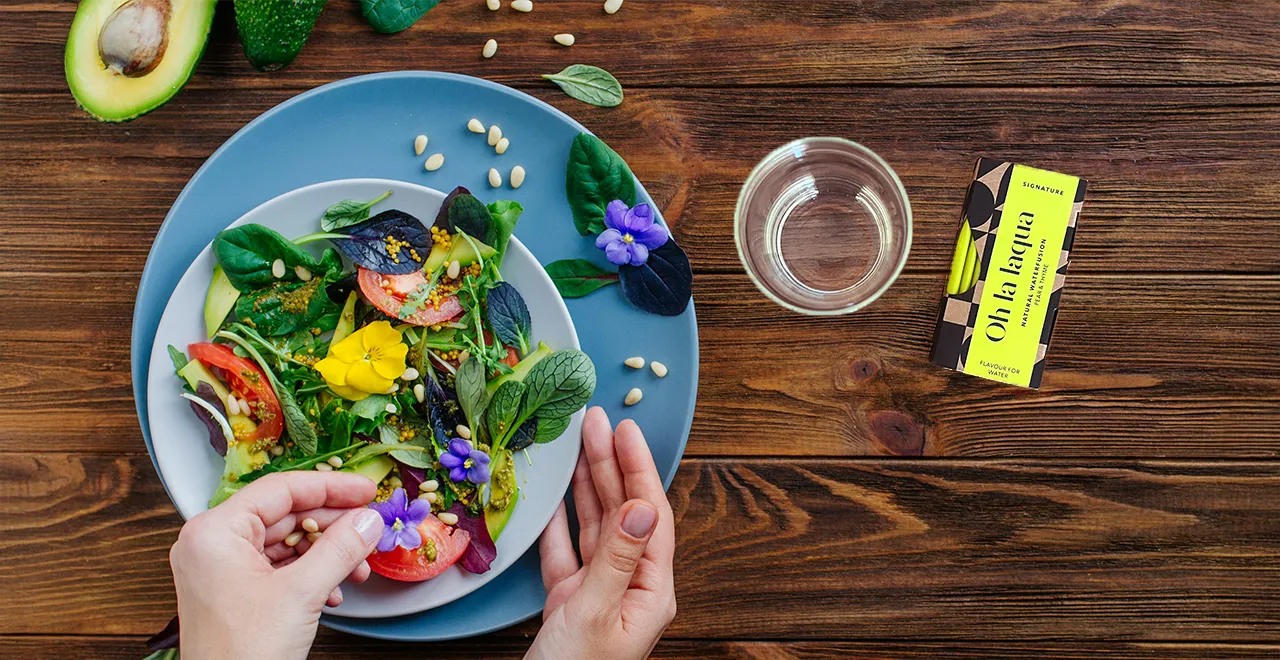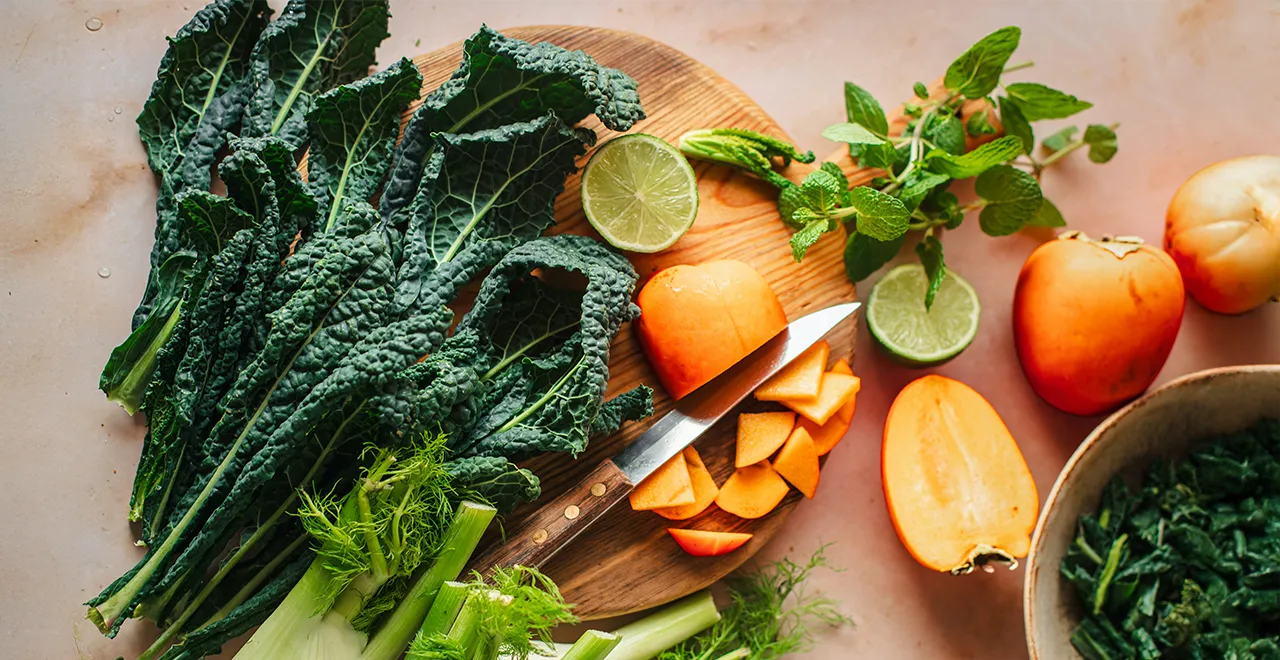Low carb diet quickly explained
„Low Carb“ bedeutet schlicht, weniger leicht verdauliche Stärke und Zucker zu essen – meist zwischen 50–130 g oder < 30 % der Tagesenergie.
Dutzende randomisierte Studien und mehrere Metaanalysen belegen eine überlegene Gewichts- und Blutzucker-Kontrolle gegenüber fettarmen Kostformen, ohne erhöhte Risiken für Nierenfunktion oder Mikronährstoffstatus.
A well-planned low-carb diet is based on lots of vegetables, high-quality protein, healthy fats and can also cover all reference values for vitamins, minerals and fiber in the long term. This makes "low carb" more of a return to historical "normal carb" ranges than an exotic fad.
Low carb diet
Topic overview:
- What is a low carb diet?
- Back to the roots: where does the low carb diet come from?
- What happens in the body when you eat low carb
- Low carb food
- Drinking properly on a low carb diet
- Conclusion
-
About the author: Nutritionist Julia Tulipan
WHAT IS LOW CARB?
Imagine going back in time 50,000 years - to a time when refrigerators, supermarkets and agriculture did not yet exist and everyday life consisted of vegetables, nuts, berries, eggs or fish and meat. This is exactly where "low carb" aims to take us: away from a constant abundance of starch and sugar and towards that exciting middle zone between the Stone Age and modernity, where carbohydrates are present but not dominant.
Medizinisch gilt eine Ernährung als low carb, wenn sie weniger als ≈ 130 g Kohlenhydrate oder < 26 % der Tagesenergie aus Kohlenhydraten liefert. Nur zum Vergleich, bei der klassischen westlichen Ernährung liegt der Kohlenhydratanteil bei 50 – 55%, was etwa 250 g Kohlenhydraten pro Tag entspricht, oder in etwa 83 Stück Würfelzucker.
BACK TO THE ROOTS - ACTUALLY NORMAL CARB
Is low-carb really that unusual? No, quite the opposite. Analyses of 229 hunter-gatherer societies show average carbohydrate levels of only 16-22%, well below today's dietary recommendations1. In other words, what we call "low" today was simply the norm for large parts of human history. The age of agriculture and farming only began 10,000 years ago. The industrialization of agriculture in the last 100 years then made pasta and pastries the cheap standard, while soft drinks drove up our liquid calories.
THIS IS WHAT HAPPENS WHEN YOU EAT LOW CARB
If the daily intake of carbohydrates falls below approx. 130 g, the body switches to a dominant fat metabolism. This also flattens out blood sugar and insulin peaks, making it easier to mobilize stored fat. The primary source of energy then becomes fat and not sugar.
Weight & body fat
Think of your muscle, liver and blood sugar stores as the battery reserve of your smartphone: As long as they are full, your body barely draws on the huge power bank on your hips. If you cut back on carbohydrates, this "sugar battery" is depleted within a day. The body switches over and taps into fat reserves.
A meta-analysis of 121 controlled studies shows that this mechanism works in practice: after six months, low-carb programs led to an average of 1.7 kg more weight loss than any other type of diet; the advantage remained even after one year2.
For you, this means that even a moderately low-carb diet (around 80-100 g a day) will allow you to tap into your fat reserves - if you want to lose weight faster, reduce to under 50 g for a few weeks and then gradually increase as soon as you reach your desired weight.
Blood sugar & diabetes
Until a few years ago, type 2 diabetes was considered an irreversible, chronic and inexorably progressing disease - but this has changed thanks to low-carb research. Large studies with several hundred participants have shown that insulin resistance and type 2 diabetes can be brought into remission through a low-carb dietary intervention.
Intervention programs such as Virta Health report that > 50 % of participants were able to reduce or discontinue their diabetes medication3. Dr. David Unwin from England published data from his practice, where he was able to achieve complete remission of the disease in 70% of people with type 2 diabetes4.
Cardiovascular markers
Many people fear that eating more fat automatically means bad cholesterol levels. But the metabolism works differently: when less sugar arrives, the liver has to produce less "emergency fat" (triglycerides). At the same time, protective HDL, which removes excess cholesterol, increases. A large meta-analysis from 2023 found a decrease of 27 mg/dl in triglycerides and an increase in HDL of 4 mg/dl in low-carb participants; LDL remained unchanged on average5 6.
Stay full longer with low carb - why protein and fat curb the "snack urge"
Carbohydrates act like instant fuel: the blood sugar shoots up within minutes, insulin rushes after it, and a short time later the low often follows. Welcome to the blood sugar rollercoaster. But if you remove precisely this ignition fuel, the peaks and troughs will stay away.
Carbohydrate-rich snacks are like flash in the pan: quick to light, quick to pass. Fats burn more slowly - they dampen the hunger hormone ghrelin and trigger satiety hormones such as GLP 1, PYY and CCK7. Protein occupies a special position, because protein is primarily a building material and not a fuel. Hormone tests have even been able to demonstrate the strong effect of protein: With protein-rich meals, GLP 1 levels rise significantly and automatically reduce the desire for second helpings8.
Practical tip: Aim for around 30 g of protein at each meal (e.g. 2 eggs plus 100 g of salmon or 150 g of tofu) and add a handful of nuts or half an avocado - this will keep you realistic for four to six hours without stomach rumbling.
Low carb food
|
Category |
Examples |
Benefit |
|
Protein |
Eggs, fish, poultry, tofu, meat |
Muscle maintenance, satiety |
|
Fats |
Olive oil, coconut oil, butter, avocado, nuts |
Omega-3/-9, fat-soluble vitamins |
|
Vegetables |
Green vegetables, broccoli, zucchinis, spinach, mushrooms, cucumber, salads |
Dietary fiber, magnesium |
|
Low-sugar fruit |
Berries, citrus fruits, avocado |
Polyphenols, vitamin C |
Clever swaps: zucchini "zoodles" instead of pasta or cauliflower rice instead of cereals.
Drinking with low carb
If you reduce carbohydrates, you not only lose sugar reserves at the beginning, but also water and minerals. This is because glycogen binds water, and when its stores shrink, the body excretes more fluids and electrolytes. To prevent tiredness, headaches or muscle cramps, it is important to drink enough - at least 1.5 to 2 liters of water or unsweetened tea per day, more if you exercise or are hot.
Soft drinks, fruit juices or sweetened mixed coffee drinks are counterproductive due to their high sugar content. If you want to support your metabolism in the best possible way, opt for water, herbal or green tea, black coffee without sugar or mineral water with a little salt or lemon - this keeps the electrolyte balance in check and allows the benefits of low carb to fully unfold.
The flavors for water from OH LA LAQUA are always a good companion for a low carb diet, as they help those who don't like drinking healthy water to drink more and avoid soft drinks.
LOW-CARB RECIPE FOR A DELICIOUS DRINK:
Peach Raspberry Shake
prepared with OH LA LAQUA Peach & Orange Blossom
6g K / 27g E / 6g F / 191 kcal p. p.
1 portion
INGREDIENTS:
- OH LA LAQUA Peach & Orange Blossom (1 stick pack)
- 300 ml roasted almond milk
- 20 g yogurt (average)
- 30 g Whey, Natural
- 50 g frozen raspberries (every day)
- 1 g stevia liquid sweetener
Put all the ingredients in a blender and pour into a nice glass. Sweeten with stevia if desired.
 Low carb drink: Peach Raspberry Shake with OH LA LAQUA Peach & Orange Blossom
Low carb drink: Peach Raspberry Shake with OH LA LAQUA Peach & Orange BlossomLOW-CARB RECIPE FOR A DELICIOUS DRINK:
Creamy Chocolate & Hazelnut Shake
prepared with sugar-free flavoring for coffee
5g K / 30g E / 17g F / 301 kcal p. p.
1 portion
INGREDIENTS:
- OH LA LAQUA Chocolate & Hazelnut (1 stick pack)
- 300 ml roasted almond milk
- 30 g 100% Pure Whey, Natural
- 15 g cocoa powder
- 1 g cinnamon (average)
- 1 g stevia liquid sweetener
Decoration
- 25 g whipped cream (whipped)
- 1 tbsp chopped hazelnuts
- 1 teaspoon chocolate flakes
Put all the ingredients in a blender and pour into a nice glass. Sweeten with stevia if desired. Decorate with whipped cream, nuts and chocolate.
 CREAMY CHOCOLATE & HAZELNUT SHAKE - simply delicious
CREAMY CHOCOLATE & HAZELNUT SHAKE - simply deliciousMy conclusion on a low carb diet
Today, low carb is one of the best-researched nutritional strategies with solid evidence: it improves weight, blood sugar and blood lipid profiles without any compelling nutritional risks. If you pay attention to quality - lots of colorful vegetables, high-quality protein, essential fats - "low carb" is not a short-lived diet trend, but an evolutionarily plausible lifestyle suitable for everyday use.
About the author: Julia Tulipan
I am Julia Tulipan, biologist, nutritionist (MSc Clinical Nutritional Medicine) and holistic health and performance coach.
I support high performers as well as ambitious specialists and managers - and health professionals on request - who want to stabilize their weight, solve fatigue and digestive problems and optimize their metabolism so that they gain more energy, mental clarity and performance in the long term. I achieve this by combining over ten years of practical experience with current evidence and developing customized nutrition, fasting and lifestyle strategies that are biologically sound, suitable for everyday use and measurably effective. What sets me apart from others is the combination of academic depth, entrepreneurial experience and wide-ranging knowledge transfer: co-author of the standard work "The Keto Compass", co-developer of the first certified KetoCoach training program in German-speaking countries as well as YouTuber and podcast host since 2015 - a reliable point of contact for undogmatic, evidence-based knowledge and clear orientation.
As part of my nutritional counseling, I am always looking for products that make it easier for my clients to give up sugar. That's why I think OH LA LAQUA is simply brilliant.
 Julia Tulipan, biologist, nutritionist (MSc Clinical Nutritional Medicine) and holistic health and performance coach
Julia Tulipan, biologist, nutritionist (MSc Clinical Nutritional Medicine) and holistic health and performance coachBibliography:
1 Ströhle, Alexander, and Andreas Hahn. "Diets of modern hunter-gatherers vary substantially in their carbohydrate content depending on ecoenvironments: results from an ethnographic analysis." Nutrition Research 31.6 (2011): 429-435. https://pubmed.ncbi.nlm.nih.gov/21745624/
2Leung , Leona Yuen-Ling, Hon-Lon Tam, and Jonathan Ka-Ming Ho. "Effects of ketogenic and low-carbohydrate diets on the body composition of adults with overweight or obesity: A systematic review and meta-analysis of randomized controlled trials." Clinical Nutrition (2025). https://www.sciencedirect.com/science/article/pii/S0261561425000184
3Adams , Rebecca N., et al. "Sustained metabolic improvements in a remotely delivered ketogenic nutrition program for veterans with type 2 diabetes: A 3-year observational study." Diabetes, Obesity and Metabolism (2025). https://pubmed.ncbi.nlm.nih.gov/40521806/
4Unwin , David, et al. "What predicts drug-free type 2 diabetes remission? Insights from an 8-year general practice service evaluation of a lower carbohydrate diet with weight loss." BMJ Nutrition, Prevention & Health 6.1 (2023): 46.
https://nutrition.bmj.com/content/6/1/46
5Tian , Wende, et al. "The effects of low-carbohydrate diet on glucose and lipid metabolism in overweight or obese patients with T2DM: a meta-analysis of randomized controlled trials." Frontiers in Nutrition 11 (2025): 1516086.
https://pmc.ncbi.nlm.nih.gov/articles/PMC11743357/
6Zhang , Yu, et al. "Low-carbohydrate diet is more helpful for weight loss than low-fat diet in adolescents with overweight and obesity: a systematic review and meta-analysis." Diabetes, Metabolic Syndrome and Obesity (2024): 2997-3007.
https://pubmed.ncbi.nlm.nih.gov/39145286/
7Moon , Jaecheol, and Gwanpyo Koh. "Clinical evidence and mechanisms of high-protein diet-induced weight loss." Journal of obesity & metabolic syndrome 29.3 (2020): 166.
https://pmc.ncbi.nlm.nih.gov/articles/PMC7539343/
8van der Klaauw, Agatha A., et al. "High protein intake stimulates postprandial GLP1 and PYY release." Obesity 21.8 (2013): 1602-1607.
https://pubmed.ncbi.nlm.nih.gov/23666746/





